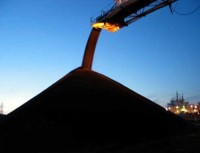Coal-to-liquid fuels poised for a comeback
 Converting coal into
Converting coal intoliquid fuels is known to be more costly than current energy
technologies, both in terms of production costs and the amount of
greenhouse gases the process emits.
Production of coal-to-liquid fuel, or CTL, has a large carbon
footprint, releasing more than twice the lifecycle greenhouse gases
of conventional petroleum fuels. However, with the rise in energy
prices that began in 2008 and concerns over energy security, there
is renewed interest in the conversion technology.
Researchers from the MIT Joint Program on the Science and Policy of
Global Change (JPSPGC) recently released
target=”_blank”>an assessment of the economic
viability of CTL conversion. The researchers looked at how
different climate policies and the availability of other fuel
alternatives, such as biofuels, would influence the prospects of
CTL in the future.
Coal-to-liquid technology has been in existence since the 1920s and
was used extensively in Germany in 1944, producing around 90
percent of the national fuel needs at that time. Since then, the
technology has been largely abandoned for the relatively cheaper
crude oil of the Middle East. A notable exception is South Africa,
where CTL conversion still provides about 30 percent of national
transportation fuel.
But will there be a resurgence of CTL technology? To determine the
role that CTL conversion would play in the future global fuel mix,
researchers examined several crucial factors affecting CTL
prospects. Different scenarios were modeled, varying the stringency
of future carbon policies, the availability of biofuels and the
ability to trade carbon allowances on an international market.

Researchers also examined whether CTL-conversion plants would
use carbon capture and storage technology, which would lower
greenhouse gas emissions but create an added cost.
The study found that, without climate policy, CTL might become
economical as early as 2015 in coal-abundant countries like the
United States and China. In other regions, CTL could become
economical by 2020 or 2025. Carbon capture and storage technologies
would not be used, as they would raise costs. In this scenario, CTL
has the potential to account for about a third of the global
liquid-fuel supply by 2050.
However, the viability of CTL would be highly limited in regions
that adopt climate policies, especially if low-carbon biofuels are
available. Under scenarios that include stringent future climate
policies, the high costs associated with a large carbon footprint
would diminish CTL prospects, even with carbon capture and storage
technologies. CTL conversion may only be viable in countries with
less stringent climate policies or where low-carbon fuel
alternatives are not available.
“In short, various climate proposals have very different impacts on
the allowances of regional CO2 emissions, which in turn have quite
distinct implications on the prospects for CTL conversion,” says
John Reilly, co-director of the JPSPGC and one of the study’s
authors.
“If climate policies are enforced, world demand for petroleum
products would decrease, the price of crude oil would fall, and
coal-to-liquid fuels would be much less competitive.”
Source: web.mit.edu

